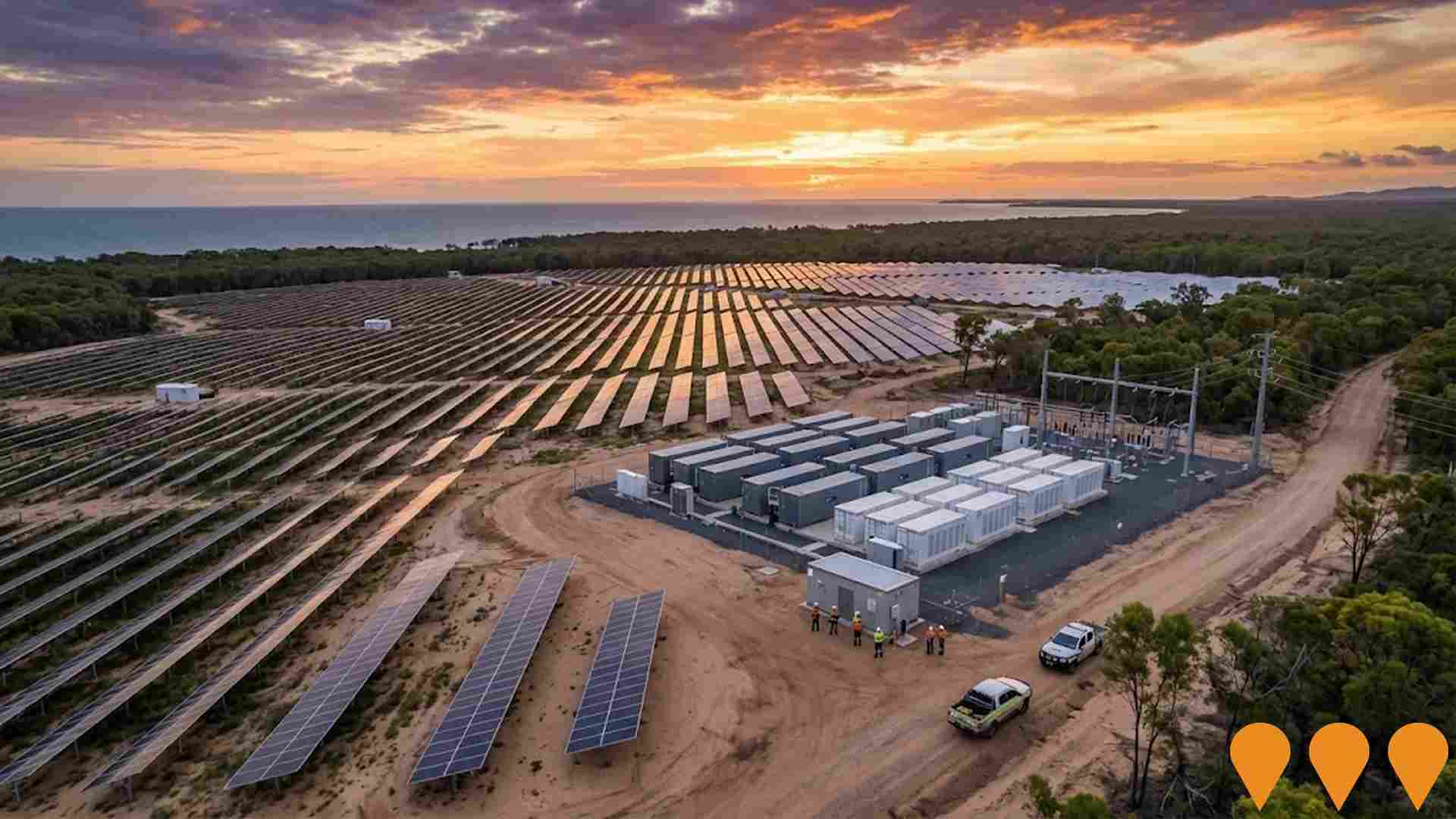Chart Color Schemes
est. as @ -- *
ABS ERP | -- people | --
2021 Census | -- people
Sales Activity
Curious about local property values? Filter the chart to assess the volume and appreciation (including resales) trends and regional comparisons, or scroll to the map below view this information at an individual property level.
Find a Recent Sale
Sales Detail
Population
An assessment of population growth drivers in Magnetic Island reveals an overall ranking slightly below national averages considering recent, and medium term trends
Magnetic Island's population was approximately 2,670 as of August 2025. This figure represents an increase of 195 people from the 2021 Census total of 2,475. The change is inferred from ABS data showing an estimated resident population of 2,638 in June 2024 and an additional 92 validated new addresses since the Census date. This results in a population density ratio of 52 persons per square kilometer. Magnetic Island's growth rate of 7.9% between the 2021 Census and August 2025 exceeded both the SA4 region (6.9%) and the SA3 area, indicating it as a leading growth area within its region. Interstate migration contributed approximately 71.8% to overall population gains during recent periods.
AreaSearch uses ABS/Geoscience Australia projections for each SA2 area released in 2024 with a base year of 2022. For areas not covered by this data and years post-2032, Queensland State Government's SA2 area projections from 2023 based on 2021 data are adopted. However, these state projections do not provide age category splits, so AreaSearch applies proportional growth weightings in line with ABS Greater Capital Region projections released in 2023 and based on 2022 data for each age cohort. Looking ahead, lower quartile growth of non-metropolitan areas nationally is anticipated, with the area expected to grow by 109 persons to reach a total population of approximately 2,879 by 2041, representing a gain of 2.9% over the 17-year period.
Frequently Asked Questions - Population
Development
Recent residential development output has been above average within Magnetic Island when compared nationally
Magnetic Island has seen approximately 26 new homes approved annually. Between financial years FY-21 and FY-25, around 131 dwellings were approved, with an additional 3 approved so far in FY-26. Over the past five financial years, on average, 1.6 people moved to the area for each dwelling built.
This indicates balanced supply and demand, creating stable market conditions. The average construction cost of new properties is $407,000, which is lower than regional levels, suggesting more affordable housing options for buyers. In FY-26, $1.8 million in commercial approvals have been registered, indicating a predominantly residential focus on the island's development. Compared to the Rest of Qld, Magnetic Island has 149.0% more building activity per person, offering buyers greater choice.
The majority of new building activity consists of detached houses (95.0%), with medium and high-density housing making up the remaining 5.0%, maintaining the area's traditional low density character. With around 104 people moving to Magnetic Island for each dwelling approval, it shows characteristics of a growth area. Population forecasts indicate that by 2041, Magnetic Island will gain approximately 77 residents. Based on current development patterns, new housing supply should meet demand, offering good conditions for buyers and potentially facilitating population growth beyond current projections.
Frequently Asked Questions - Development
Infrastructure
Magnetic Island has emerging levels of nearby infrastructure activity, ranking in the 37thth percentile nationally
No infrastructure changes significantly affect an area's performance. AreaSearch identified zero projects impacting this region. Key projects are Weststate Private Hospital, Douglas Water Treatment Plant Clarifiers Upgrade, Bruce Highway (Townsville-Ingham) upgrade program, and Sunshine State Solar Farm and Battery. The following list details those most relevant.
Professional plan users can use the search below to filter and access additional projects.
INFRASTRUCTURE SEARCH
 Denotes AI-based impression for illustrative purposes only, not to be taken as definitive under any circumstances. Please follow links and conduct other investigations from the project's source for actual imagery. Developers and project owners wishing us to use original imagery please Contact Us and we will do so.
Denotes AI-based impression for illustrative purposes only, not to be taken as definitive under any circumstances. Please follow links and conduct other investigations from the project's source for actual imagery. Developers and project owners wishing us to use original imagery please Contact Us and we will do so.
Frequently Asked Questions - Infrastructure
Queensland Energy and Jobs Plan
State-wide renewable energy transformation program delivering large-scale wind, solar, pumped hydro, battery storage and transmission infrastructure. Aims for 70% renewable energy by 2032 and 80% by 2035, supporting 100,000 jobs by 2040 across regional Queensland. Largest clean energy investment program in Australia.
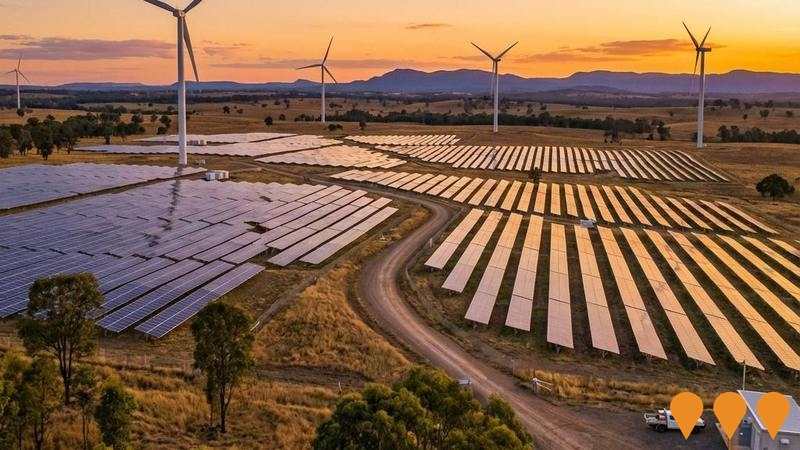
Queensland Energy and Jobs Plan SuperGrid
The Queensland Energy and Jobs Plan is delivering the Queensland SuperGrid and 22 GW of new renewable energy capacity through Renewable Energy Zones (REZs) across the state. Legislated targets are 50% renewables by 2030, 70% by 2032 and 80% by 2035. Key delivery mechanisms include the Energy (Renewable Transformation and Jobs) Act 2024, the SuperGrid Infrastructure Blueprint, the Queensland REZ Roadmap and the Priority Transmission Investments (PTI) framework. Multiple transmission projects are now in construction including CopperString 2032, Gladstone PTI (Central Queensland SuperGrid), Southern Queensland SuperGrid reinforcements, and numerous grid-scale batteries and pumped hydro projects under active development.
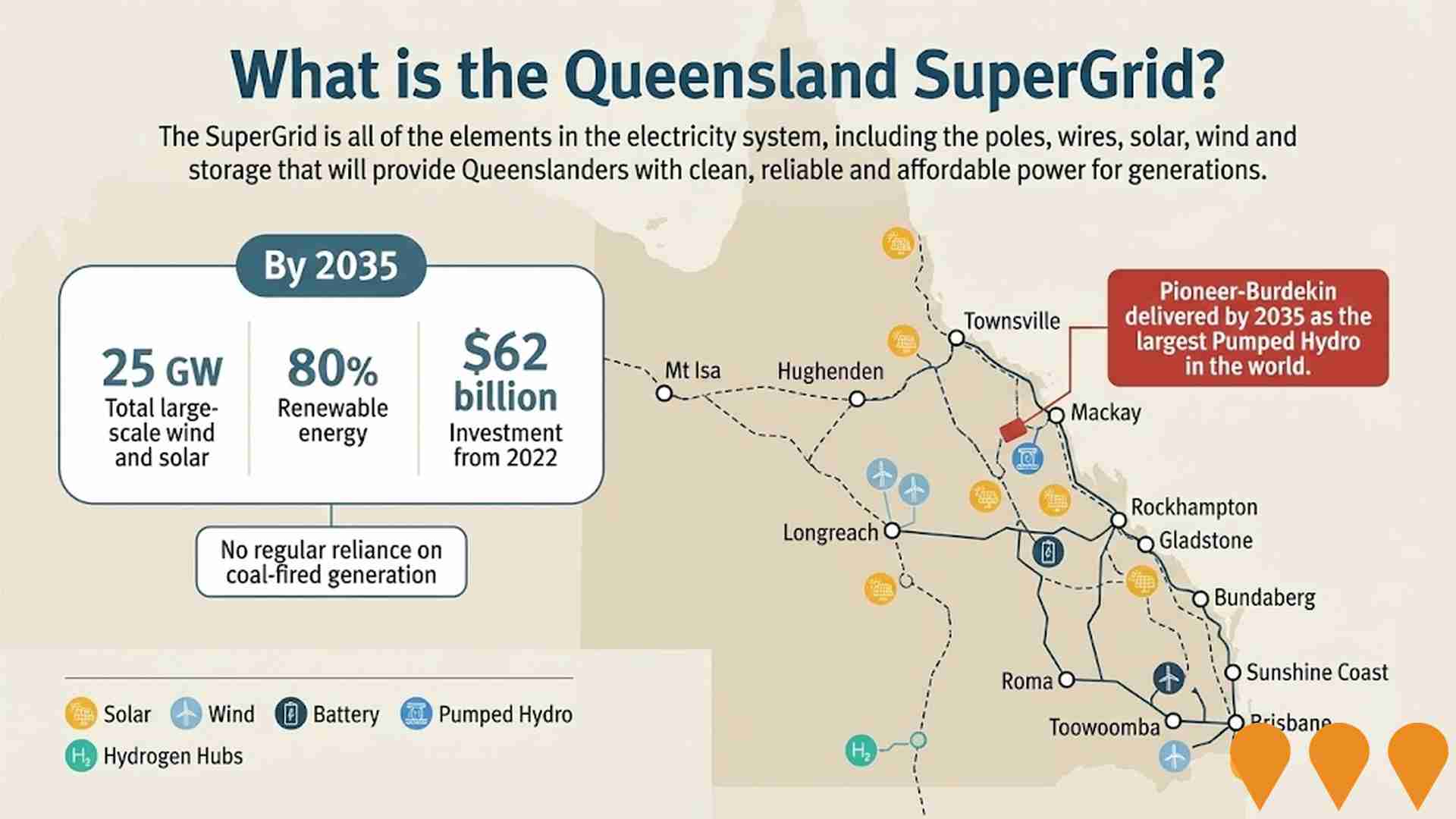
Queensland Energy and Jobs Plan
The Queensland Energy and Jobs Plan is a $62 billion+ statewide program to deliver publicly owned renewable energy generation, large-scale battery and pumped hydro storage, and the Queensland SuperGrid transmission backbone. Targets: 50% renewables by 2030, 70% by 2032, 80% by 2035. Multiple projects are now under construction including CopperString 2032, Pioneer-Burdekin Pumped Hydro, and numerous Renewable Energy Zones.
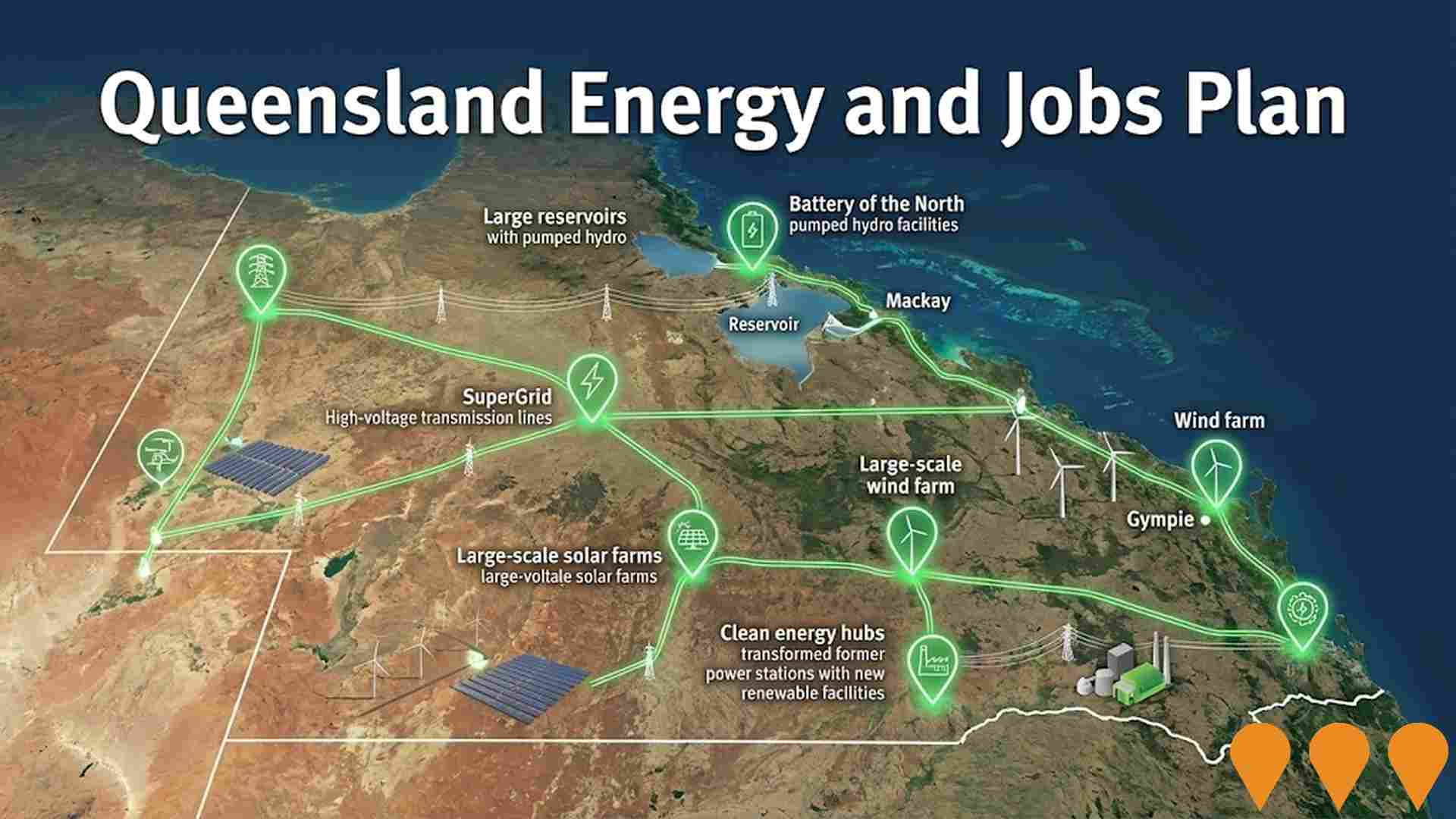
Weststate Private Hospital
New five-storey short-stay private hospital on the former West State School site in West End, Townsville. Features four operating theatres, one procedure room, 19 day-surgery beds and 26 overnight beds. Construction commenced February 2022. Despite reported disputes in 2024-2025 between fund-through developer Centuria Healthcare and operator partner, works remain active on site as of November 2025 with structural framing and facade installation progressing.
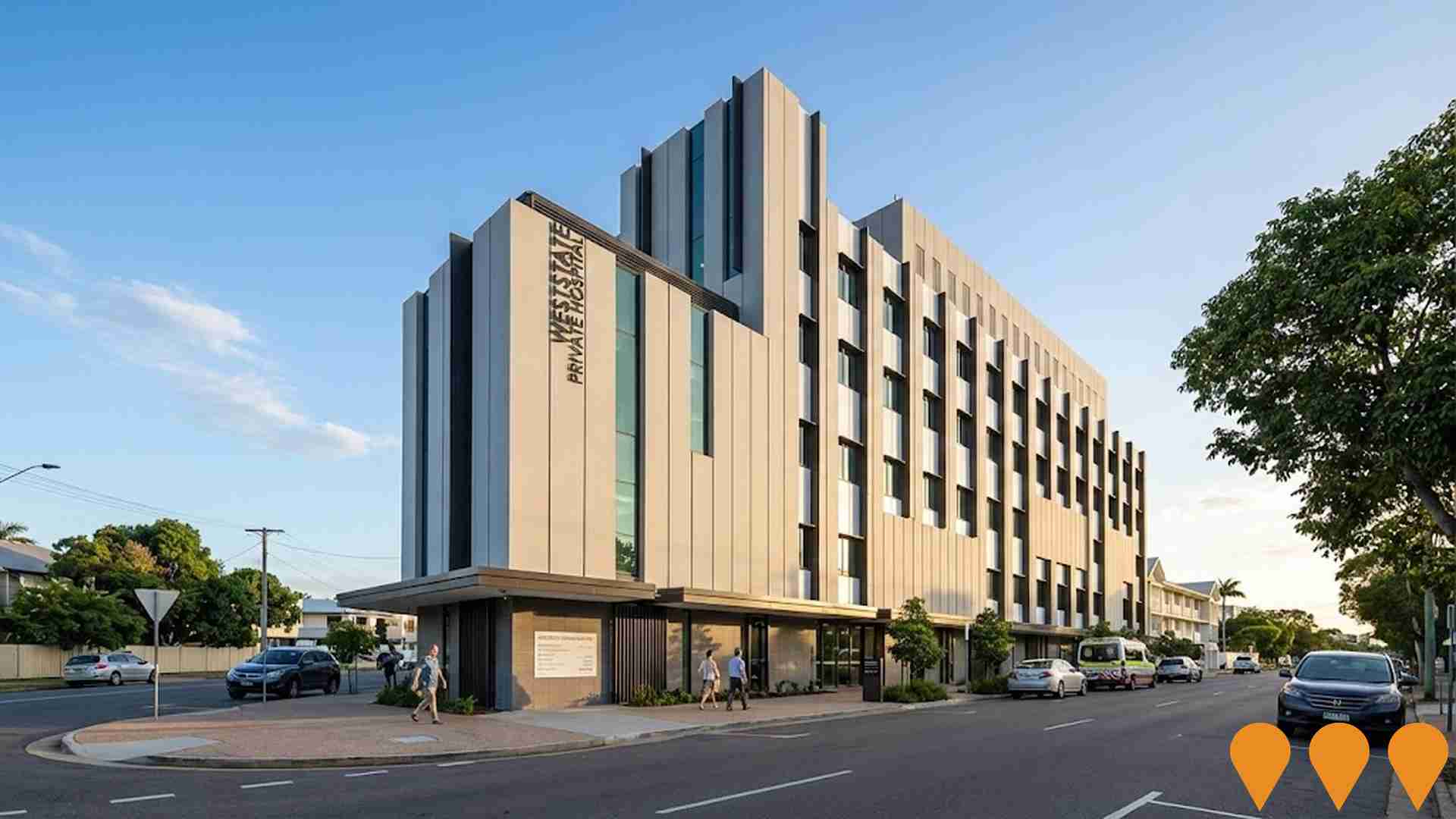
Bruce Highway Upgrade Program
The Bruce Highway Upgrade Program is Queensland's largest road infrastructure initiative, delivering safety, flood resilience, and capacity improvements along the 1,677km corridor from Brisbane to Cairns. The massive investment program includes the $9 billion Targeted Safety Program, major bypass projects (including Gympie, Rockhampton, and Tiaro), bridge replacements, and wide centre line treatments. Jointly funded by the Australian and Queensland governments, works are progressing across multiple sections simultaneously.
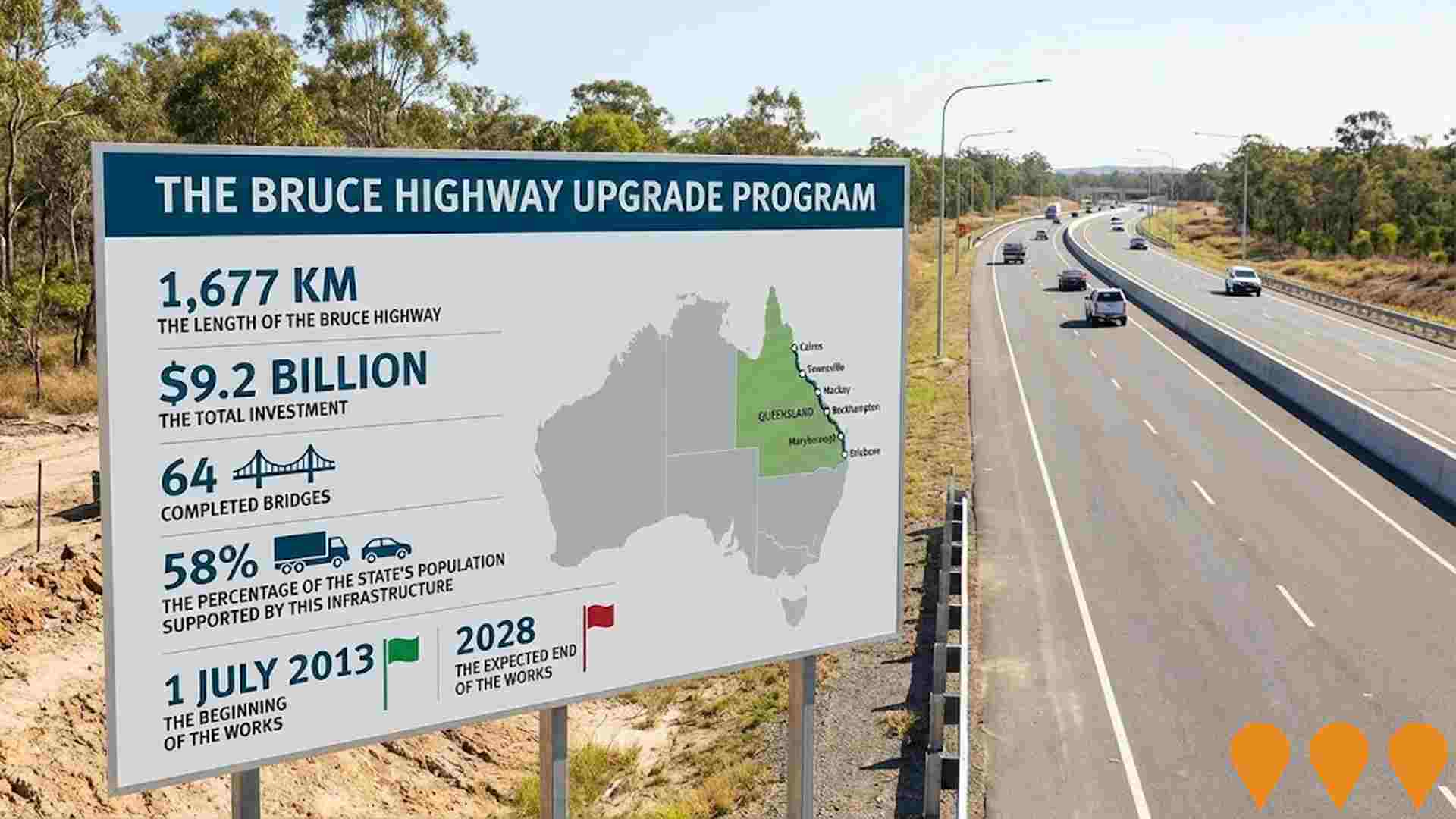
CopperString 2032
The CopperString 2032 project involves constructing approximately 840 km of high-voltage electricity transmission lines to connect Queensland's North West Minerals Province to the National Electricity Market. It includes a 500 kV line from Townsville to Hughenden, a 330 kV line from Hughenden to Cloncurry, a 220 kV line from Cloncurry to Mount Isa, along with substations and supporting facilities. The project is prioritizing the Eastern Link with private investment sought for the Western Link.
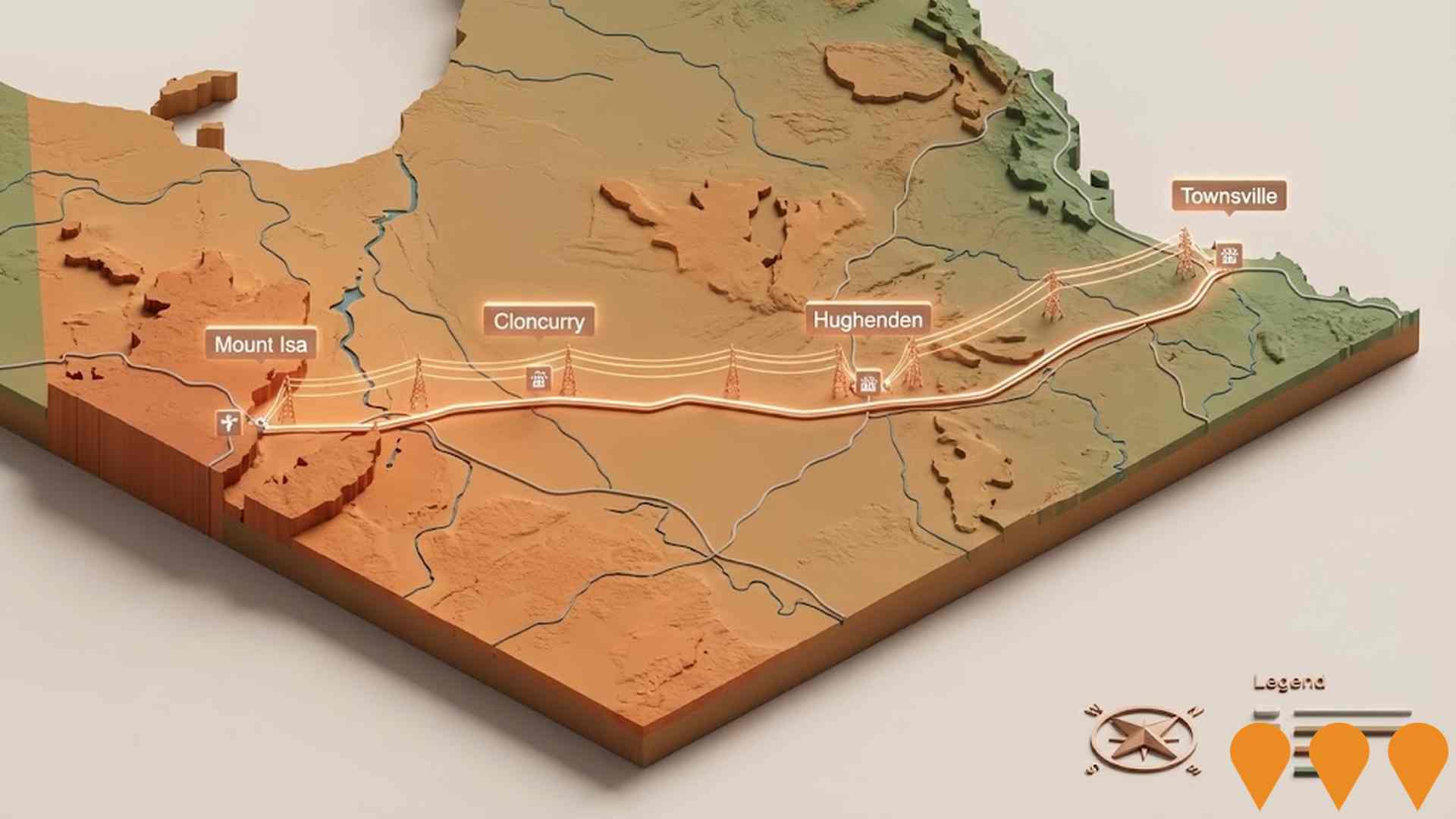
Douglas Water Treatment Plant Clarifiers Upgrade
The project involved the installation of two new clarifiers at the Douglas Water Treatment Plant to double the number of clarifiers, enhancing water treatment capacity during tropical weather events and providing additional water security for Townsvilles growing population. The new infrastructure treats 950 litres per second through Module 3 and 1100 litres per second through Module 4.
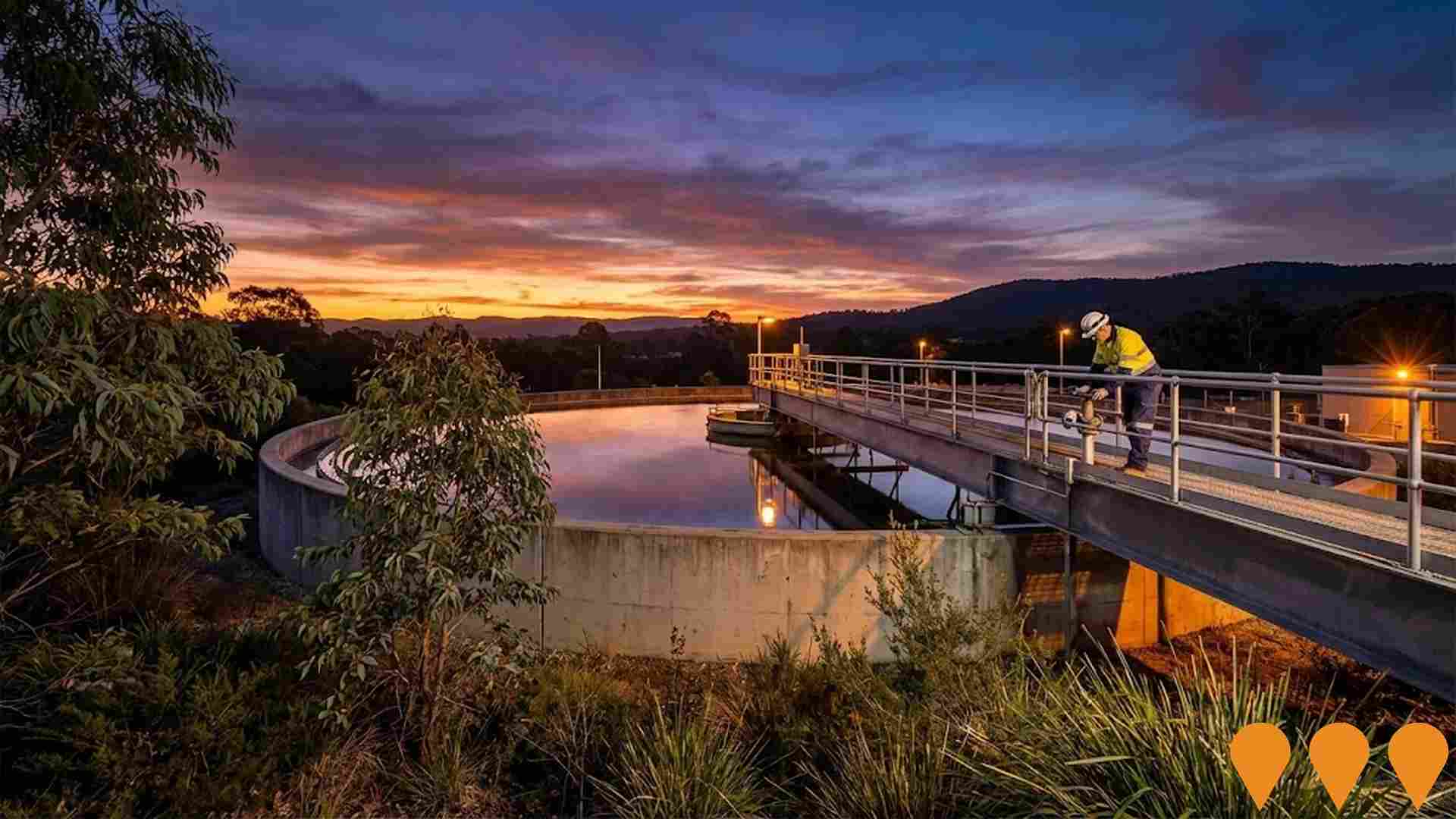
Bowen Basin Gas Pipeline
A proposed 500km gas transmission pipeline to connect coal seam gas reserves in the Bowen Basin to the east coast domestic market and overseas customers via existing pipeline infrastructure. The project completed Phase 1 concept study in December 2021 and Phase 2 market engagement in December 2022. Phase 2 findings showed market interest exists but timing is critical for investor confidence. The pipeline could potentially transport up to 457 TJ/d of gas from three main regions: Moranbah (200 TJ/d), Blackwater (77 TJ/d), and Mahalo (180 TJ/d). The preferred route (Option 2B) would run approximately 390km from the Bowen Basin to connect with existing infrastructure near Rolleston. The project also aims to capture coal mine methane emissions to reduce fugitive emissions and support Queensland's transition to a low-carbon economy.

Employment
Employment conditions in Magnetic Island face significant challenges, ranking among the bottom 10% of areas assessed nationally
Magnetic Island's workforce is well-educated with tourism and hospitality sectors prominent. As of June 2025, the unemployment rate was 7.0%.
In June 2025, 1,105 residents were employed while the unemployment rate was 3.1% higher than Rest of Qld's rate of 3.9%, indicating room for improvement. Workforce participation on Magnetic Island lags at 47.1%, compared to Rest of Qld's 59.1%. Employment is concentrated in accommodation & food, health care & social assistance, and retail trade. The island shows strong specialization in accommodation & food with an employment share of 2.5 times the regional level.
However, health care & social assistance employs only 11.3% of local workers, below Rest of Qld's 16.1%. The area offers limited local employment opportunities as seen by Census working population vs resident population count. Between June 2024 and June 2025, the labour force decreased by 1.8%, while employment declined by 4.8%, leading to a 2.9 percentage point rise in unemployment rate. In contrast, Rest of Qld saw employment growth of 1.8% and labour force growth of 2.0%, with a 0.2 percentage point rise in unemployment rate. Jobs and Skills Australia's national employment forecasts from May 2025 project national employment growth of 6.6% over five years and 13.7% over ten years, but growth rates vary significantly between sectors. Applying these projections to Magnetic Island's employment mix suggests local growth of approximately 6.4%% over five years and 13.1% over ten years, though this is a simple weighting extrapolation for illustrative purposes only.
Frequently Asked Questions - Employment
Income
Income metrics place the area in the bottom 10% of locations nationally according to AreaSearch analysis
Magnetic Island's median income among taxpayers in financial year 2022 was $39,504. The average income stood at $51,856 during the same period. In comparison, Rest of Qld had a median income of $50,780 and an average income of $64,844. Based on Wage Price Index growth of 13.99% since financial year 2022, estimated median and average incomes as of September 2025 would be approximately $45,031 and $59,111 respectively. According to the 2021 Census, household, family and personal incomes in Magnetic Island fall between the 3rd and 15th percentiles nationally. The income bracket of $800 - 1,499 dominated with 28.8% of residents (768 people), contrasting with the surrounding region where the $1,500 - 2,999 bracket led at 31.7%. Housing affordability pressures were severe on Magnetic Island, with only 84.7% of income remaining, ranking at the 6th percentile nationally.
Frequently Asked Questions - Income
Housing
Magnetic Island is characterized by a predominantly suburban housing profile, with above-average rates of outright home ownership
Dwelling structure within Magnetic Island, as evaluated in the latest Census, comprised 83.6% houses and 16.3% other dwellings (semi-detached, apartments, 'other' dwellings). In comparison, Non-Metro Qld had 81.3% houses and 18.7% other dwellings. Home ownership on Magnetic Island was at 49.1%, with mortgaged dwellings at 23.4% and rented ones at 27.5%. The median monthly mortgage repayment in the area was $1,353, lower than Non-Metro Qld's average of $1,517. The median weekly rent figure on Magnetic Island was recorded at $290, compared to Non-Metro Qld's $305. Nationally, Magnetic Island's mortgage repayments were significantly lower than the Australian average of $1,863, while rents were substantially below the national figure of $375.
Frequently Asked Questions - Housing
Household Composition
Magnetic Island features high concentrations of lone person households and group households, with a lower-than-average median household size
Family households account for 58.9% of all households, including 11.8% that are couples with children, 37.6% consisting of couples without children, and 8.2% made up of single parent families. Non-family households constitute the remaining 41.1%, with lone person households at 36.4% and group households comprising 4.8% of the total. The median household size is 1.9 people, which is smaller than the Rest of Qld average of 2.5.
Frequently Asked Questions - Households
Local Schools & Education
Magnetic Island performs slightly above the national average for education, showing competitive qualification levels and steady academic outcomes
The area's educational profile is notable regionally with university qualification rates at 28.6% of residents aged 15+, exceeding the SA4 region average of 20.1% and Rest of Qld's rate of 20.6%. Bachelor degrees are most common at 18.5%, followed by postgraduate qualifications (7.4%) and graduate diplomas (2.7%). Vocational credentials are prominent, with 39.8% of residents aged 15+ holding such qualifications - advanced diplomas at 13.2% and certificates at 26.6%.
A significant 22.3% of the population is actively pursuing formal education, including 8.7% in primary, 6.3% in secondary, and 2.8% in tertiary education. Magnetic Island State School serves the local community with an enrollment of 125 students and provides typical Australian school conditions (ICSEA: 1028), offering balanced educational opportunities. The area has one school focused exclusively on primary education, with secondary options available nearby due to limited local capacity (4.7 places per 100 residents vs regional average of 16.7). Many families travel to nearby areas for schooling due to this limitation.
Frequently Asked Questions - Education
Schools Detail
Nearby Services & Amenities
Transport
Transport servicing is moderate compared to other areas nationally based on assessment of service frequency, route connectivity and accessibility
Magnetic Island has 51 active public transport stops. These include both ferry and bus services. There are two routes operating in total, which together facilitate 500 weekly passenger trips.
The island's transport accessibility is considered good, with residents typically living within 320 meters of the nearest stop. On average, there are 71 daily trips across all routes, equating to about nine weekly trips per individual stop.
Frequently Asked Questions - Transport
Transport Stops Detail
Health
Health performance in Magnetic Island is well below average with prevalence of common health conditions notable across both younger and older age cohorts
Health data indicates significant challenges for Magnetic Island's population. The prevalence of common health conditions is notable across both younger and older age groups. Private health cover stands at approximately 46%, covering about 1,233 people, compared to Queensland's overall rate of 53.3% and the national average of 55.3%.
Arthritis and mental health issues are the most prevalent conditions, affecting 11.4% and 7.9% of residents respectively. About 63.2% of residents report no medical ailments, compared to 67.8% in the rest of Queensland. The island has a higher proportion of seniors, with 36.1% (964 people) aged 65 and over, compared to 14.9% in the rest of Queensland. Despite this, health outcomes among seniors are strong, even better than those of the general population.
Frequently Asked Questions - Health
Cultural Diversity
The level of cultural diversity witnessed in Magnetic Island was found to be above average when compared nationally for a number of language and cultural background related metrics
Magnetic Island's cultural diversity was found to be above average, with 7.3% of its population speaking a language other than English at home and 27.6% born overseas. Christianity was the predominant religion on Magnetic Island as of 2016, comprising 41.3% of the population. Notably, Buddhism was overrepresented in Magnetic Island compared to the rest of Queensland, making up 2.6% versus 0.9%.
The top three ancestry groups were English at 32.8%, Australian at 23.7%, and Irish at 11.8%. Other ethnic groups with notable divergences included French at 0.8% (versus 0.4% regionally), Scottish at 9.3% (versus 7.7%), and Dutch at 1.7% (versus 1.0%).
Frequently Asked Questions - Diversity
Age
Magnetic Island ranks among the oldest 10% of areas nationwide
Magnetic Island's median age is 57 years, which is considerably higher than Queensland's average of 41 years and the national norm of 38 years. The age profile shows that those aged 65-74 are particularly prominent at 23.7%, while those aged 15-24 are comparatively smaller at 6.2%. This concentration of the 65-74 age group is well above the national average of 9.4%. Between 2021 and present, the proportion of those aged 75 to 84 has grown from 8.2% to 9.6%, while the 45 to 54 cohort has declined from 11.8% to 9.1% and the 55 to 64 group has dropped from 23.7% to 21.5%. By 2041, demographic projections reveal that the number of those aged 85 and above is expected to rise substantially by 58 people (76%), reaching a total of 135. The population growth until 2041 will primarily be driven by residents aged 65 and older, representing 75% of anticipated growth. Conversely, population declines are projected for those aged 5-14 and 15-24.

